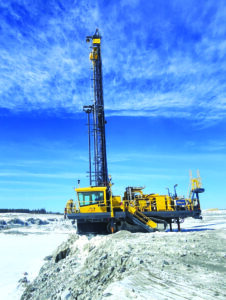
Above, an autonomous Pit Viper 271. (Photo: Epiroc)
Drill rig OEMs race to perfect autonomous and remote control solutions and technologies, and eye horizontal integration
By Jesse Morton, Technical Writer
The big innovations in surface drilling include key advances in autonomous and remote control technologies and solutions. Both are said to improve rig performance and uptime while offering safety and sustainability benefits. Separately, one OEM announced a partnership for horizontal integration. As digital solutions proliferate in mining, the demand is growing for those solutions to be capable of integrating. Certainly, suppliers will take action to meet that demand. Meanwhile, an OEM reported that demand remains solid for basic, relatively low-tech rigs, revealing another, less discussed trend in demand that suppliers are also willing to meet.
New Rigs Offer Autonomous Drilling
Epiroc announced the Pit Viper 231 E and the Pit Viper 235 E, electric-driven blasthole drills equipped with the Rig Control System (RCS) for autonomous and remote control capabilities.
The Pit Viper 231 E can drill 152- to 250-mm dia. holes to 16.1 m deep. The Pit Viper 235 E can drill 171- to 270-mm dia. holes.
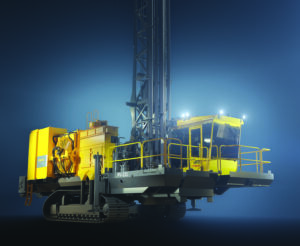
The new Pit Viper 231 E can drill 250-mm dia. holes to 16.1 m deep. (Image: Epiroc)
An expert at Epiroc said the drills are key additions to the popular series. The rigs “maintain the legendary productivity and reliability of the Pit Viper line,” said Yara Hussein, global product manager, mid-range blasthole solutions. They offer the “full range of drilling options to meet current and future needs.”
Autonomous and remote control capabilities can help a miner resolve current needs. “These electric-driven drills can potentially address labor constraints by offering advanced automation that enhances safety and productivity from a control room,” she said.
“Epiroc’s proprietary RCS offers advanced on-board and off-board automation that significantly enhances safety, accuracy, and productivity,” Hussein said. “RCS allows the operators to instead become controllers and, along with their management, choose their desired level of interaction with the harsh drilling conditions.”
Both rigs offer increased uptime and lower costs. “The elimination of traditional fuel consumption gives substantial operational cost savings,” Hussein said.
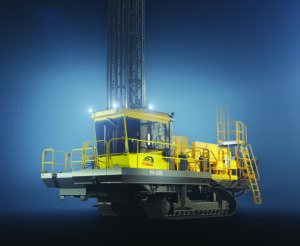
The new Pit Viper 235 E can drill 270-mm dia. holes. (Image: Epiroc)
“The electric motors Epiroc designs into the electric range ensures increased life of the powertrain,” she said. “The reduced maintenance intrusion and reduced circulation of fuel means no fuel filters or risks of system contamination, which reduces the mine’s operational expenses.”
The rigs provide operators with “safe, clean, and more sustainable operations,” she said. “Electrification options like our hydraulic cable reel coupled with
the precision of RCS take out operator manual intervention and creates the most comfortable conditions for a driller.” The rigs produce less noise than their diesel equivalents.
The Pit Viper 231 E and 235 E can help an operation achieve sustainability goals. “The electric drill range answers the customers’ needs for a zero-emission solution to align with increasingly stringent environmental regulations,” Hussein said. “The Pit Viper 231 E and Pit Viper 235 E showcase a proactive approach to reducing CO2 emissions, aligning with sustainability goals, and positioning the operation favorably for investment.”
The announcement caps decades of researching, developing, and supplying electric drilling solutions. “The first electric drill, Pit Viper 351 E, was designed in 2002, followed by the development of Drill Master L E in 2007, the Drill Master 75 E, Pit Viper 271 E and Pit Viper 275 E in 2009,” Hussein said. “And now the Pit Viper 231 E and Pit Viper 235 E complete the full hole range offering.”
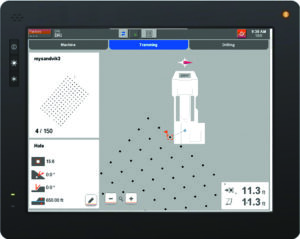
Sandvik’s iSeries rotary drill rigs all feature DRi, a new platform that supports autonomous, remote control, and machine monitoring systems and technologies. Above a drill pattern supported by DRi. (Image: Sandvik)
Separately, Epiroc reported it will deploy a fifth Pit Viper in April 2024 to join the fleet at IAMGOLD Corp.’s Côté Gold Project, an open pit mine in the Sudbury District of Ontario. The rigs are equipped with Mobius for Drills, which imports drill plans, collects data, and enables multi-machine control; and 3D-P, Epiroc’s connectivity solution.
Leadership at the mine said the fleet will help the mine become the first fully automated haulage and drilling mine in Canada. “The existing four Pit Viper rigs are progressing towards full autonomous mode,” said Francis Letarte-Lavoie, operations manager, Côté Gold.
More recently, Epiroc said that its surface drill rigs are now verified to be compatible with HVO100 fuel, and customers can immediately begin using it as an alternative to, or mixed with, diesel. Use of the hydrotreated vegetable oil gives “a substantial reduction of particulates and other harmful substances, including greenhouse gases.”
The development is an important step in helping the supplier and its customers meet sustainability goals, Epiroc said. “Epiroc has ambitious sustainability targets for 2030, and we continuously strive to improve our offering by finding more sustainable solutions,” said Martin Johansson, global product portfolio manager, Epiroc Surface division.
The HVO100 is compatible with the product ranges of SmartROC, FlexiROC, PowerROC, Christensen, Explorac and Boyles.
In October, Epiroc announced the new generation of the SmartROC C50, which will feature a new smart graphical interface and improved fuel efficiency. “The new generation of SmartROC C50 is now fitted with an updated RCS, which improves fuel efficiency up to 5%,” Epiroc said. “The smart RCS system constantly monitors compressor load and keep track of engine RPM to ensure no fuel is wasted and that environmental impact is kept to a minimum.”
The new technology offers the precision and consistency that leads to improved productivity. “The SmartROC C50 delivers improved blast-results,” said Ulf Gyllander, global product manager, Epiroc. “It will be beneficial throughout the operation, and the smart technology assists the operator every step of the way.”
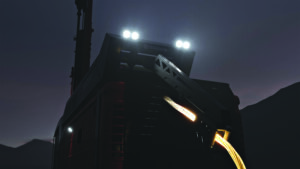
Sandvik’s new electric-cabled surface down-the-hole (DTH) drill rig is capable of drilling 229-mm holes and can tram for 7 hours powered by a battery pack.
Common Control Platform Speeds Evolution
Sandvik automation and drill rig experts revealed how iSeries rotary drill rig models now evolve in unison.
The DR410i, DR412i, DR413i, and DR416i all feature DRi, a new platform built on the Sandvik Intelligent Control System Architecture (SICA). The common platform supports autonomous, remote control, and machine monitoring systems and technologies. It allows the supplier to offer the exact same features, updates and upgrades, as soon as they are available, on each model.
“Prior to DRi, Sandvik had to develop new features and copy them over, one model at a time, but now, Sandvik can develop it once and make it available across all iSeries models,” said Demetre Harris, product manager, surface automation, rotary drills. “With DRi, all iSeries drills are on the same platform, meaning one software version, making control features, tools and upgrades easy to deploy, support, and enhance.”
Customers with multiple iSeries units report the common platform facilitates maintenance and offers efficiencies that translate to savings. “Our customers have commended Sandvik on the design of our drilling solutions and the ease to troubleshoot our drilling machines,” said Nellaiappan Subbiah, product manager, rotary drills.
“This is all made possible through DRi, and the technology and capabilities built on the platform,” he said. “The DRi platform makes troubleshooting easier for maintenance specialists both at the rig and remotely from the factory through our patented onboard diagnostic capabilities and our remote connectivity options.”
DRi enables updates and upgrades to be rapidly deployed across a fleet of iSeries machines. “We can roll out changes across all the models because they’re all sharing the same platform,” Harris said.
“When new features are added, the customer has the luxury of accessing all the new benefits across all products,” he said. The common control system helps reduce the amount of operator training needed on a new iSeries model. “Overall, DRi has allowed Sandvik to deploy, support, and train more efficiently, and to get new features and improvements out of the factory, tested, drilling in the pit, and satisfying customer needs faster than before.”
Common hardware, such as PLCs, joysticks, sensors and controls, streamlines and simplifies inventory management. “This allows large mining organizations to share stock and even operators across different mining operations with the same or different iSeries drill models if the need ever arises,” Subbiah said.
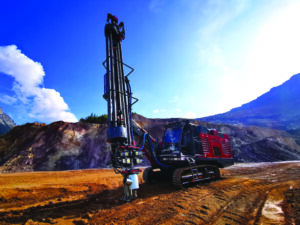
Once made in Austria, the mining-class RTD32 rig, above, will be made in Pennsylvania. (Photo: RTDrill)
The common platform and the technologies and capabilities it supports help operators achieve desired performance metrics. The DRi control system has “functional interlocks, alerts and warnings to help the operator in operating the machine in a safer manner, ensuring that productivity and utilization targets are met while eliminating machine abuse,” Harris said. “Mining operations can perform diagnostics and monitor performance to catch a problem before it impacts production.”
Machine health and operator performance data can be analyzed by Sandvik specialists who can advise on optimizing machine utilization and productivity. “The data can then be fed into Sandvik Digital Solutions such as MySandvik Onsite and MySandvik Productivity to be visualized through dashboards to report the rig health, work modes, utilization and productivity,” Subbiah said. The resulting information allows “top performers to be recognized, improvements to be identified, and actions to be taken that lead to increased productivity, lower costs, and higher profits.”
The DRi platform also allows the data from a rig to be integrated with that of solutions by other OEMs “to help accurately plan for blasting and achieve optimal fragmentation,” he said.
SICA has been used by Sandvik mining solutions for more than 15 years. Development of DRi launched in 2020. “The first model to receive it was the DR410i in 2021,” Harris said. “Every rig model that received the DRi upgrade has been fully tested and validated at the factory and in the pit,” he said. “The DRi extension of SICA has been in place for a little more than a year, and has streamlined development, support and change management of our iSeries drilling solutions.”
Currently there are more than 1,000 iSeries machines connected to the cloud for data analytics. “Each connection boosts the production and utilization for large mining houses,” Subbiah said. “The benefits provided through Sandvik digital solutions because of DRi have assisted mining operations with lowering blasting costs, improving efficiency, and increasing productivity.”
Separately, in late November, Sandvik announced an electric surface down-the-hole (DTH) drill rig that is capable of drilling 229-mm holes. With a 180-m cable, the unit can also be powered by a battery pack for an hour of drilling or up to 7 hours of tramming. The battery pack can help increase rig uptime, Sandvik said.
“The battery means greater freedom and flexibility and more efficient use of time, as the rig can drill immediately while the cable is being set up,” said Lauri Laihanen, vice president, R&D, Surface Drilling Division.
The 1,000-volt cable tightens itself automatically, and is wound on a single layer. The rig is currently scheduled for field testing, Sandvik reported.
In May, 2022, Sandvik introduced a smaller top-hammer battery-electric concept surface drill rig that is being tested at construction sites.
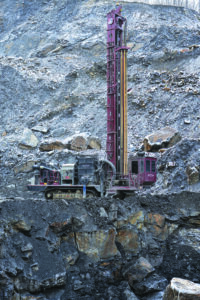
The popular RTD55 has minimal sensors, giving it superior uptime and speed of meters drilled, RTDrill said. (Photo: RTDrill)
Big OEMs Partner on Integration
Caterpillar and Orica reported partnering to explore opportunities to improve real-time data exchange and to integrate workflows. They will initially seek to integrate Orica’s Rhino, BlastIQ, and FRAGTrack technologies with Cat MineStar Terrain.
The integration could give high-fidelity rock property information, enabling improvements to on-bench safety, drilling and blasting program accuracy and productivity, and higher quality blast outcomes that generate enhanced mill performance, Orica said. Going forward, the partnership will seek opportunities to optimize the entire value chain from mine to mill.
Orica said the development speaks to an industry trend. “The mining industry requires greater collaboration amongst its leading technology players to build connected workflows across different domains to address the current issue of value-leakage arising from traditional and disconnected silos,” said Rajkumar Mathiravedu, vice president, Orica Digital Solutions. “Collaborative end-to-end ecosystems are critical to harnessing the full potential of advances in sensors, data processing and intelligence to enable the development of safer, more sustainable, and productive methods of resource recovery.”
Popular Rigs Now Made in U.S.
RTDrill said the RTD28 and RTD32 will now be manufactured in the U.S. “Those two models were previously manufactured in our factory in Austria,” said Bruno Lordey, territory manager, Eastern U.S. and Canada. “However, now, their production has been moved to our factory in Philipsburg, Pennsylvania,” he said. “So today we can proudly say that all our drill rigs are 100% manufactured in the USA.”
The larger unit, the RTD32, is routinely sold to mines “thanks to its compressor holding 406 PSI and the ability to drill holes up to 203 mm dia. for a maximum depth of 49 m,” Lordey said.
The articulated DTH rig offers high productivity. “The RTD32 would be a great addition to any fleet. Many different options can be added to it,” he said. “Even for mining exploration drilling or grade control, we have the capability of adding a reverse circulation kit thanks to our sister company, Technidrill, which makes that kit along with reverse circulation tools such as drill pipes and subs.”
Earlier this year RTDrill reported it deployed an RTD32 to a surface operation in Kentucky, U.S., where it was drilling 2.4 m per minute. The company also published photos of an RTD55 rig prepped for delivery and loaded on a transit truck at the factory in Pennsylvania.
The RTD55 is the most popular mining rig the supplier sells. Customers select it for the superior uptime and speed of meters drilled, RTDrill said.
The model is designed for rotary and DTH multi-pass, has 9.1-m drill pipes in a carousel that can hold up to six. For DTH, it can drill a 172-mm hole to 60 m. Equipped with a dual-motor system rotary head, it can drill hole sizes up to 229 mm. The rotary head can deliver up to 7,300 Nm torque.
The rig comes with either a (Tier-III or -IV) Cat C15 or a Cummins QSX 15 (up to 433-kW) engine with a low- or high-pressure (8.6- or 25.5-Bar) compressor that delivers up to 31.1-m3/min. The two-man, falling-object protection certified, air-conditioned cab features electric-hydraulic controls.
Other than those controls, the unit is made with relatively few electronic components and sensors, meaning it can sustain abuse without stopping, giving it high availability.
The supplier expects “a significant growth in production,” Lordey said. “We are really excited about it,” he said. “Don’t forget to stop and see us in September in Las Vegas at MINExpo to learn more about our drill rigs and our expertise.”
This article was published previously in the January 2024 edition of Engineering & Mining Journal.






